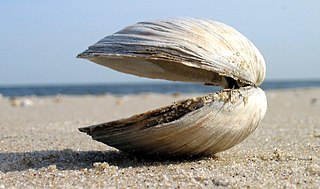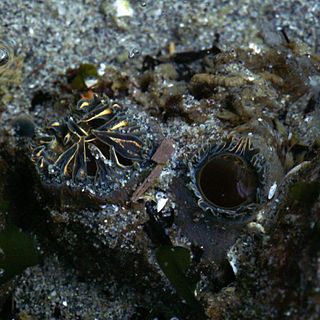
Clam is a common name for several kinds of bivalve molluscs. The word is often applied only to those that are edible and live as infauna, spending most of their lives halfway buried in the sand of the seafloor or riverbeds. Clams have two shells of equal size connected by two adductor muscles and have a powerful burrowing foot. They live in both freshwater and marine environments; in salt water they prefer to burrow down into the mud and the turbidity of the water required varies with species and location; the greatest diversity of these is in North America.

A seashell or sea shell, also known simply as a shell, is a hard, protective outer layer usually created by an animal or organism that lives in the sea. The shell is part of the body of the animal. Empty seashells are often found washed up on beaches by beachcombers. The shells are empty because the animal has died and the soft parts have decomposed or been eaten by another animal.

The Unionidae are a family of freshwater mussels, the largest in the order Unionida, the bivalve molluscs sometimes known as river mussels, or simply as unionids.

Tresus capax is a species of saltwater clam, marine bivalve mollusk, common name the fat gaper, in the family Mactridae. It also shares the common name horse clam with Tresus nuttallii a species which is similar in morphology and lifestyle. Both species are somewhat similar to the geoduck, though smaller, with shells up to eight inches long (20 cm), weight to 3–4 lb (1.4–1.8 kg).

Corbicula fluminea is a species of freshwater clam native to eastern Asia which has become a successful invasive species throughout the world, including North America, South America, Europe, and New Zealand. It is native to freshwater environments of Eastern Asia, including Russia, Thailand, the Philippines, China, Taiwan, Korea, and Japan. C. fluminea also occurs naturally in freshwater environments of Africa. Corbicula fluminea is commonly known in the west as the Asian clam, Asiatic clam, or Asian gold clam. In Southeast Asia, C. fluminea is known as the golden clam, prosperity clam, pygmy clam, or good luck clam. In New Zealand, it is commonly referred as the freshwater gold clam.

The Corbiculidae are a family of clams in the mollusc order Venerida. They are known commonly as basket clams. The family name comes from the root corbus ("basket"), and was inspired by the concentric ribbing of the shells.

Corbicula is a genus of freshwater and brackish water clams, aquatic bivalve mollusks in the family Cyrenidae, the basket clams. The genus name is the Neo-Latin diminutive of Latin corbis, a basket, referring to the shape and ribs of the shell.

Theodoxus fluviatilis, common name the river nerite, is a species of small freshwater and brackish water snail with a gill and an operculum, an aquatic gastropod mollusk in the family Neritidae, the nerites.

Hippopus hippopus, also known as the Horse Hoof clam and Strawberry clam, is a species of giant clam in the Subfamily Tridacninae and the genus Hippopus. Hippopus is a delicacy in many Southeast Asian countries due to its high quality meat.

Lampsilis higginsii is a rare species of freshwater mussel known as Higgins' eye pearly mussel or simply Higgins' eye. It is endemic to the United States, where it occurs in the upper Mississippi River and the drainages of some of its tributaries. It is threatened by the introduced zebra mussel. Lampsilis higginsii is a federally listed endangered species.

The razor shell, Ensis magnus, also called razor clam, razor fish or spoot (colloquially), is a bivalve of the family Pharidae. It is found on sandy beaches in Canada and northern Europe.

The Mediterranean mussel is a species of bivalve, a marine mollusc in the family Mytilidae. It is an invasive species in many parts of the world, and also an object of aquaculture.

Astarte borealis, or the northern astarte, is a species of bivalve mollusc in the family Astartidae. It can be found along the Atlantic coast of North America, ranging from Greenland to Massachusetts.
Obovaria arkansasensis, the Southern Hickorynut, is a species of freshwater mussel, an aquatic bivalve mollusc in the family Unionidae, the river mussels. It lives in the southern United States, and has a complex life history including its larvae being parasitic on a fish host.
Potamocorbula amurensis is a species of small saltwater clam, a marine bivalve mollusc in the order Myida. Common names include the overbite clam, the Asian clam, the Amur River clam and the brackish-water corbula. The species is native to marine and brackish waters in the northern Pacific Ocean, its range extending from Siberia to China, Korea and Japan. It has become naturalised in San Francisco Bay.

Corbicula japonica is an edible species of brackishwater clam, a bivalve mollusk in the family Cyrenidae, the basket clams. Its common names include Japanese basket clam, Japanese blue clam, and shijimi.

Arcuatula senhousia, commonly known as the Asian date mussel, Asian mussel or bag mussel, is a small saltwater mussel, a marine bivalve mollusk species in the family Mytilidae, the mussels. Other common names for this species include: the Japanese mussel, Senhouse's mussel, the green mussel, and the green bagmussel. It is harvested for human consumption in China.














